Vibration Analysis – Smooth Savings for Your Operations
Vibration Monitoring is the most common element of a holistic preventative maintenance concept called Condition Monitoring. Until fairly recently, common practice was for maintenance of many objects to be performed at regular intervals; that is, according to the calendar. Data over many decades has proven this approach to be unhelpful: equipment failure tends not to happen over time, but rather shortly after maintenance was performed. Preventative Maintenance has therefore given way to Predictive Maintenance, which relies heavily upon continuous monitoring as a diagnostic tool.
Protection of rotating machinery is the primary application for Vibration Monitoring. These include pumps, power plants, refrigeration plants, gearboxes, pulleys, fans, compressors and conveyor drives. Failure causes like loose or broken parts, instability, misalignment, imbalance, rubbing parts and bearing wear can be separately identified with vibration analysis. Equipment can be automatically shut down when vibration becomes excessive if the right monitoring system is in place. Advantages for using vibration monitoring equipment as part of a predictive maintenance program include:
- reduced downtime
- reduced chances of overhaul & catastrophic failure
- increased production run quantities
- lower spare parts inventories
- improved use of management time
- improved quality statistics.
When operators can actively monitor rotating machinery, they can identify, correct and prevent expensive damage and downtime. Also, a skilled technician can use a Vibration Monitoring device to perform quality control, lower manufacturing costs by keeping production machinery operating at peak efficiency, assisting in new product design, and handling field service issues.
Vibration is typically measured as vibration acceleration in meters per second squared. Acceleration is the rate of change of velocity in speed or direction in a given unit of time. Another factor is called vibration exposure direction, and frequencies and exposure duration are other important safety factors. The factor of acceleration is what determines how much harm the vibration can cause a person.
Vibration acceleration is typically measured with an accelerometer, which acts like the human sensitivity to the vibration of different frequencies. The reading is turned into an electrical signal proportional to the acceleration. This becomes the frequency-weighted vibration exposure in meters per second squared. Vibration Monitoring
Eliminate Unnecessary Injuries
Since many Canadian jurisdictions have not mandated vibration exposure regulations, the Threshold Limit Values and guidelines recommended by the American Conference of Governmental Industrial Hygienists (ACGIH). Vibration exposure can cause short and long term health issues. Dangers are split into two categories: hand-arm vibration and full-body vibration.
Hand-arm vibration issues come from hand-held tools. ACGIH recommendations give maximum accelerations and exposure durations which workers can be exposed to without severe damage to fingers. The common injury is called White Finger, in which fingertips become tingly, numb, lose dexterity and change color as blood circulation decreases.
Full-body vibration exposure comes from unnatural seating positions combined with vibration. Operators of trucks, forklifts and off-road vehicles often experience this. Guidelines are given by ACGIH recommendations in three kinds of exposure limits. First, the reduced-comfort boundary, which limits exposure for passengers and crew to eat, read or write during travel on airplanes, boats and trains.
Second, the fatigue-decreased proficiency boundary sets limits for operating airplanes, driving or operating heavy vehicles because of time-dependent effects. Low frequency vibrations can induce sleep; high frequency vibrations can have the opposite result.
Third, the exposure limit determines the limit of exposure for whole-body vibration.
Severe discomfort boundaries are recommended for certain time periods in the 0.1 – 0.63 Hz range. However, keep in mind that individuals will react differently to the effects of vibration. These figures are not “safe upper limits”.
Methods for controlling exposure to vibration include anti-vibration tools and gloves, safe work practices, employee education, and vibration control design. Vibration Monitoring
Source by: Andrew Cunningham, Territory Sales Manager – REED Instruments
